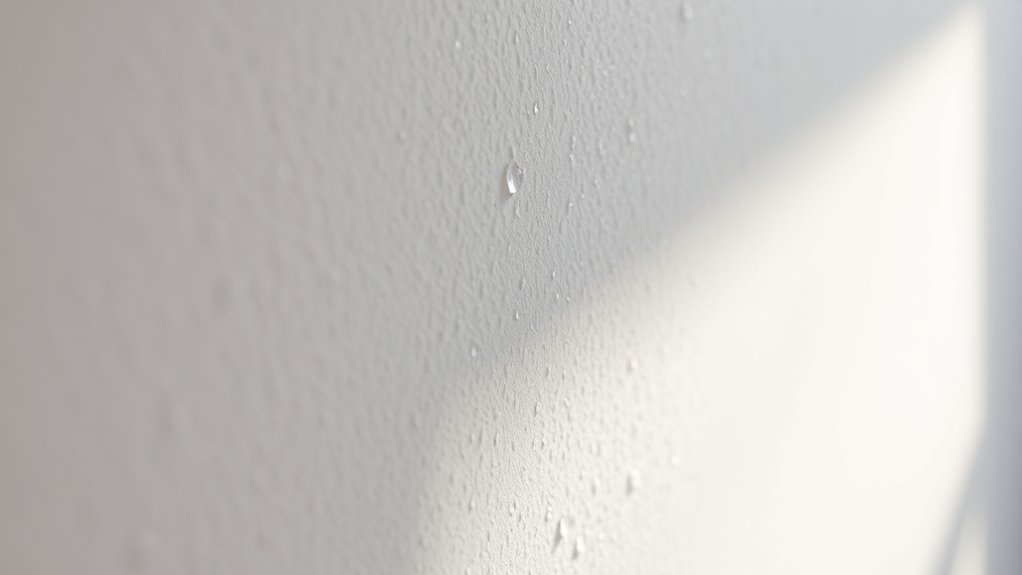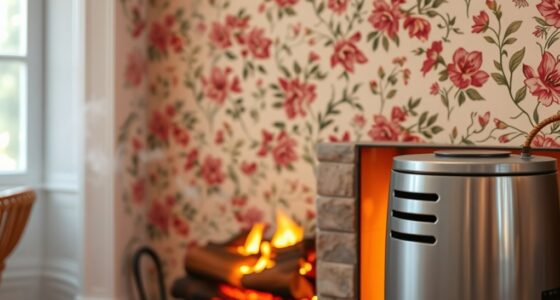To prevent wall moisture caused by condensation, keep indoor humidity below 50%, use dehumidifiers, and ensure proper ventilation with exhaust fans or open windows. Insulate your walls to maintain warmer surfaces that stay above the dew point, reducing condensation. Monitoring indoor moisture levels helps you adjust settings proactively. By controlling these factors, you create a drier environment that protects your walls from dampness. If you want to learn more, there are simple techniques to enhance your home’s moisture control.
Key Takeaways
- Maintain indoor humidity below 50% to reduce condensation risk on walls.
- Improve wall insulation to keep surface temperatures above the dew point.
- Ensure proper ventilation with exhaust fans or natural airflow to remove excess moisture.
- Use dehumidifiers and hygrometers to monitor and control indoor moisture levels.
- Seal walls with vapor barriers and enhance insulation to prevent dampness and mold growth.

Have you ever wondered why dew forms on grass in the morning? It all comes down to the air’s humidity and temperature. When warm, moist air comes into contact with cooler surfaces like grass or walls, the moisture condenses into tiny water droplets. This natural process, called condensation, can lead to unwanted moisture buildup inside your home, especially on walls and ceilings. To prevent this, understanding dew point and controlling the environment are essential.
One effective way to reduce condensation is by managing humidity levels inside your home. High humidity increases the likelihood of moisture forming on surfaces, so using a dehumidifier or proper ventilation can make a significant difference. Keeping indoor humidity below 50% helps prevent the air from becoming saturated with moisture, reducing the chance of dew forming on walls. Ventilation is particularly important in areas prone to moisture, such as kitchens and bathrooms. Using exhaust fans or opening windows helps exchange humid indoor air with drier outdoor air, maintaining a healthier environment and protecting your walls from dampness.
Managing indoor humidity with dehumidifiers and ventilation prevents wall condensation and dampness.
In addition to humidity control, employing insulation techniques plays a key role in preventing condensation on walls. Insulation acts as a barrier that keeps interior surfaces warmer, so they stay above the dew point temperature. When walls are well-insulated, they’re less likely to reach the cool temperatures that promote condensation. For example, adding insulation to exterior walls or installing vapor barriers helps maintain consistent surface temperatures, reducing the risk of moisture accumulation. Proper insulation not only improves energy efficiency but also minimizes the chances of mold growth, structural damage, and other issues caused by persistent dampness.
It’s essential to recognize that condensation often occurs when warm, moist air comes into contact with cold surfaces. By controlling humidity and maintaining proper insulation, you create an environment where the dew point is less likely to be reached on your walls. This means your walls stay dry, healthy, and free from mold or rot. Keep an eye on your indoor humidity levels with a hygrometer, and take steps to increase insulation if walls feel cold or damp. These measures work hand-in-hand to protect your home from moisture problems and ensure a comfortable living space. Additionally, advancements in AI and automation are enabling smarter climate control systems that can monitor and adjust humidity and temperature levels automatically, further helping to prevent condensation issues.
Frequently Asked Questions
How Can I Measure the Dew Point in My Home Accurately?
You can measure the dew point in your home accurately by using a digital hygrometer combined with a thermometer. These devices help you monitor humidity control and temperature levels precisely. Look for models that have a dew point calculator or app compatibility. Regularly checking these readings allows you to adjust your indoor humidity and temperature, preventing condensation and wall moisture issues effectively.
What Are Signs of Hidden Wall Moisture Caused by Condensation?
Hidden moisture often whispers through wall deterioration, subtly revealing itself before visible signs appear. You might notice peeling paint, mold patches, or a musty smell lingering in the air. Cold spots on walls or unexplained dampness are clues that hidden moisture caused by condensation is at work. Ignoring these signs risks structural damage, so stay alert—early detection can save your walls from silent decay and costly repairs.
Can Mold Growth Occur Without Visible Condensation?
Yes, mold can grow without visible condensation because hidden moisture often accumulates inside walls or behind surfaces. Poor air circulation traps humidity, creating a damp environment ideal for mold growth even if you don’t see water on the surface. You should regularly check for signs like a musty smell or discolored patches, and improve air circulation to help prevent hidden moisture and mold development.
Are There Specific Paints to Prevent Wall Condensation?
Yes, there are specific paint solutions that help prevent wall condensation. You can use moisture-resistant coatings designed for high-humidity areas, which create a barrier against moisture buildup. These specialized paints reduce the chances of condensation forming on your walls, helping to keep your space dry and mold-free. Look for products labeled as mold-resistant or humidity-resistant to guarantee you’re choosing the best option for preventing wall moisture.
How Does Outdoor Weather Influence Indoor Dew Point Levels?
Did you know that outdoor humidity and seasonal temperature changes directly impact indoor dew point levels? When outdoor humidity rises, it increases the likelihood of indoor condensation, especially during colder months. As temperatures drop, the dew point lowers, making walls more prone to moisture. You can manage this by monitoring outdoor weather conditions, ensuring proper ventilation, and maintaining consistent indoor temperatures to reduce wall moisture risks.
Conclusion
Understanding dew point and condensation helps you prevent wall moisture effectively. For example, if you notice a damp patch in your basement during winter, it’s likely due to warm indoor air meeting cold walls and causing condensation. By controlling indoor humidity and insulating surfaces, you can stop this from happening. Keep an eye on temperature and moisture levels to protect your home from costly damage and maintain a healthier living environment.









